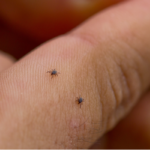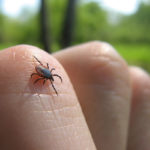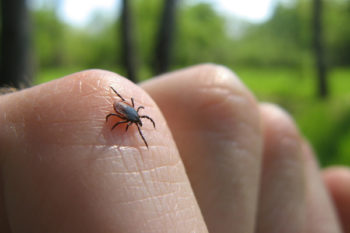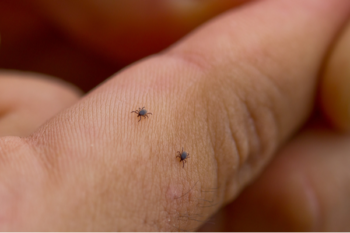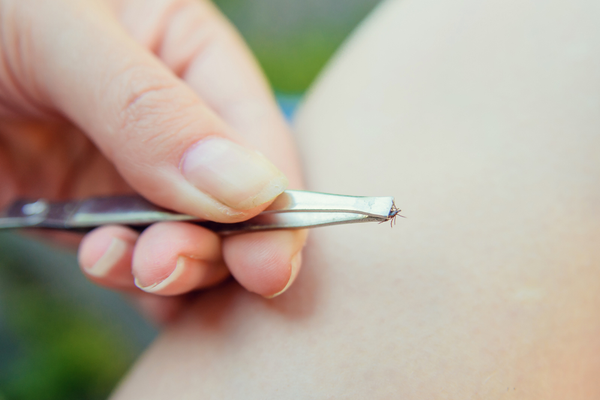
The best way to remove a tick is always to use fine-tipped tweezers to grip the tick’s as close to your skin as possible and pull straight upward, with firm, gradual, and consistent pressure. Don’t try to yank or twist the tick out as you pull and go slowly.
Proper tick removal is very important. If you don’t remove the tick cleanly and completely, you may inadvertently leave behind pieces of its mouth parts of the body behind in the wound. Unfortunately, a frustrating amount of misinformation about the right way to remove a tick has made learning the proper technique somewhat difficult. To set the record straight, here are the definitive “dos” and “don’ts” of tick removal. Next time you have to remove a tick from yourself, your children, or your pets, keep these dos and don’ts in mind:
Do

1. Act fast
Ticks take 24 hours to transmit the diseases they may carry to human hosts. The faster you can pull attached ticks off of you, the less danger they represent. You should prepare to remove the tick from your body as soon as you find it whenever possible.
2. Use the proper tweezer technique
No matter what you’ve heard, the right way to remove a tick is always using tweezers. Get a set of fine-tipped tweezers or specialized dual-tipped tick removal tweezers and follow each of these steps:
a: Grip the tick firmly as close to the surface of your skin as possible. Try to lock the tweezers around the tick’s mouthparts (this may be impossible depending on how far the tick has burrowed).
b: Pull straight up (away from your skin) with steady, firm, and gradual pressure. If you feel the tweezer’s grip slipping at any point, reset.
c: Remove the tick all at once and store it in a jar or cup nearby.
d: If pieces of the tick remain behind in the wound after you extract the body, carefully attempt to remove the pieces using the tweezers. Be careful not to hurt yourself! If you can’t easily remove the pieces, try washing them out or leave them alone until you heal.
3. Preserve or safely dispose of the tick
Preserving the tick in alcohol or a sealed bag can help your doctor or a pest control professional identify it. Consider keeping the tick for a week or two. If you develop symptoms, take the preserved tick with you to the doctor for identification.
If you don’t want to preserve the tick, then wrap it in tape or foil, place it inside a sealed plastic bag, or flush it down the toilet.
4. Wash the wound
After removing the tick, you should immediately wash and disinfect the bite wound. Use a disinfectant such as rubbing alcohol or simply wash thoroughly with soapy water. Take this opportunity to check the bite wound for leftover pieces of the tick.
5. Visit the doctor in you develop symptoms
If the site of the bite swells, breaks out in a rash, itches, or inflamed, or if you develop a fever or other symptoms of illness one to four weeks after you remove the tick, visit a doctor. Tell the doctor when and where you were bitten by the tick, how long the tick may have been attached to you, and how long it’s been since you removed it. If you have the tick, bring it with you to the appointment.
Do not
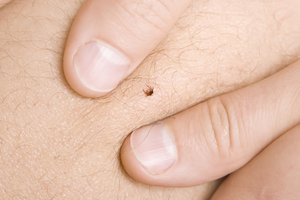
1. Panic
Even if you don’t know how long the tick has been attached, you should never panic when you find it. Ticks won’t suddenly burrow deeper, detach, or defend themselves in any way as you attempt to remove them. Stay calm and remove the tick as soon as you can.
2. Use an “alternative” removal method
The tweezers technique is always the right way to remove ticks. Do not try “burn” the tick off with a match, “drown” it with rubbing alcohol or water, or “freeze” it with ice. Not only are these techniques ineffective, but they may actually get the tick to burrow deeper into your skin.
3. Twist or yank at the tick
When removing the tick, you should always pull straight and steadily, even if you can’t seem to remove the tick at first. Never yank the tick suddenly, twist it, or attempt to “wiggle” it out of the wound. Doing so could break off pieces of the tick in the wound even if you remove it. These pieces could still transmit disease or infect your skin, and they’re harder to remove than the full tick.
4. Crush the tick
After you’ve removed the tick, you should never crush or squish it by hand. Pieces of the tick could get stuck in your fingers or hands, and it may secrete blood or another blood that could infect your skin or transmit diseases. Instead, preserve the tick or dispose of it safely with a bag or foil.
One last don’t: don’t forget that we’re here to help. If you have any questions about removing, identifying, or preventing ticks, don’t hesitate to give Griffin Pest Solutions a call. We can find ticks near you, identify them, and keep them away for good.

